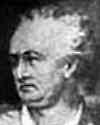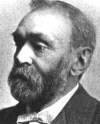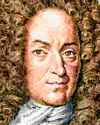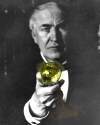 | TODAY IN SCIENCE HISTORY NEWSLETTER - 21 OCTOBER |
| Feature for Today |
 On 21 Oct, in different years, two U.K. patents were issued. On 21 Oct, in different years, two U.K. patents were issued.In 1852, John Fowler was issued a patent, believed to be the first for steam-powered cultivation of land, which in this application was to mechanise land drainage. You can read about his invention, and his obituary, here.  In 1824, Joseph Aspdin patented what is known as Portland cement. How it is manufactured, what distinguishes it from Roman cement, and the text of his patent, can be read here. |
| Book of the Day | |
| |
| Quotations for Today | |
 | "If I have a thousand ideas and only one turns out to be good, I am satisfied." |
 | "Briefly, in the act of composition, as an instrument there intervenes and is most potent, fire, flaming, fervid, hot; but in the very substance of the compound there intervenes, as an ingredient, as it is commonly called, a material principle and as a constituemt of the whole compound the material and principle of fire, not fire itself. This I was the first to call phlogiston." |
 | "Object, ....to effect imitation of all done by gas, so as to replace lighting by gas by lighting by electricity..." |
| QUIZ | |
| Before you look at today's web page, see if you can answer some of these questions about the events that happened on this day. Some of the names are very familiar. Others will likely stump you. Tickle your curiosity with these questions, then check your answers on today's web page. | |
| Births | |
 |  A Swedish chemist and inventor of dynamite and other, more powerful explosives, was born in Stockholm on 21 Oct 1833. An explosives expert like his father, in 1866 he invented a safe and manageable form of nitroglycerin he called dynamite, and later, smokeless gunpowder and (1875) gelignite. He helped to create an industrial empire manufacturing many of his other inventions and amassed a huge fortune, much of which he left in a fund to endow the annual prizes that bear his name. A Swedish chemist and inventor of dynamite and other, more powerful explosives, was born in Stockholm on 21 Oct 1833. An explosives expert like his father, in 1866 he invented a safe and manageable form of nitroglycerin he called dynamite, and later, smokeless gunpowder and (1875) gelignite. He helped to create an industrial empire manufacturing many of his other inventions and amassed a huge fortune, much of which he left in a fund to endow the annual prizes that bear his name. Can you name this scientist? Can you name this scientist? |
| Deaths | |
 |  James Henry Greathead (1844-1896) was a British civil engineer who improved a basic tool of a certain type of construction. It had been invented by Marc Isambard Brunel though in an unwieldy form, and subsequently modified by Peter W. Barlow. Greathead, having studied with Barlow further modified the tool and used it in construction in London. James Henry Greathead (1844-1896) was a British civil engineer who improved a basic tool of a certain type of construction. It had been invented by Marc Isambard Brunel though in an unwieldy form, and subsequently modified by Peter W. Barlow. Greathead, having studied with Barlow further modified the tool and used it in construction in London. His great contribution to what type of construction? His great contribution to what type of construction? |
| Events | |
| |  On 21 Oct of a certain year, the first U.S. photocell or tube which was publicly demonstrated was shown by the Westinghouse Electric and Mfg Co at the Electrical Show at Grand Central Palace in New York. The sensitivity of the photocell to light was used to count objects as they passed through and interrupted a beam of light. It was also shown applied to open doors as a person or car approached. On 21 Oct of a certain year, the first U.S. photocell or tube which was publicly demonstrated was shown by the Westinghouse Electric and Mfg Co at the Electrical Show at Grand Central Palace in New York. The sensitivity of the photocell to light was used to count objects as they passed through and interrupted a beam of light. It was also shown applied to open doors as a person or car approached. In what decade was this photocell announced? In what decade was this photocell announced? |
 |  On 21 Oct 1879, Thomas A. Edison successfully demonstrated the first durable and commercially practical electric light bulb at his laboratory in Menlo Park, New Jersey. The idea of electric lighting was not new; several people had worked on and even developed forms of electric lighting. However, nothing had been developed that was practical for home use. The difficulty was finding a suitable material for the filament. On 21 Oct 1879, Thomas A. Edison successfully demonstrated the first durable and commercially practical electric light bulb at his laboratory in Menlo Park, New Jersey. The idea of electric lighting was not new; several people had worked on and even developed forms of electric lighting. However, nothing had been developed that was practical for home use. The difficulty was finding a suitable material for the filament. For how many hours did his first demonstration lightbulb burn? (Give your answer to the nearest 10 hours) For how many hours did his first demonstration lightbulb burn? (Give your answer to the nearest 10 hours) |
| Answers |
When you have your answers ready to all the questions above, you'll find all the information to check them, and more, on the October 21 web page of Today in Science History. Or, try this link first for just the brief answers. Fast answers for the previous newsletter for October 20: Cavendish Laboratory, Cambridge; originated quantum mechanics and the spinning electron theory; the decade containing the year 1906; Peace. |
| Feedback |
 If you enjoy this newsletter, the website, or wish to offer encouragement or ideas, please send feedback by using your mail reader Reply button. If you enjoy this newsletter, the website, or wish to offer encouragement or ideas, please send feedback by using your mail reader Reply button. |
--
If you do not want to receive any more newsletters, this link
To update your preferences and to unsubscribe visit this link
If you do not want to receive any more newsletters, this link
To update your preferences and to unsubscribe visit this link
! !



Δεν υπάρχουν σχόλια:
Δημοσίευση σχολίου